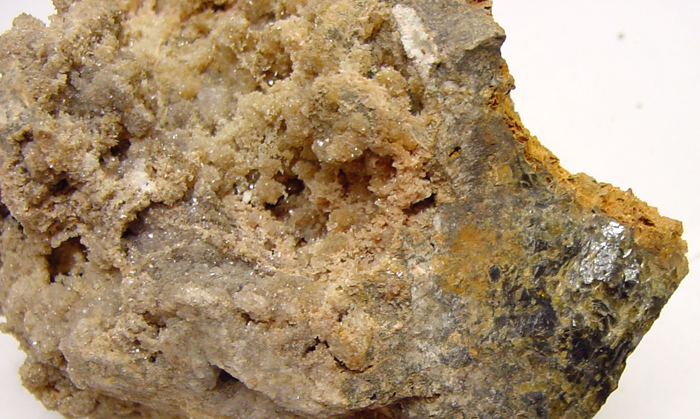|
White Vitriol
Zinc sulfate is an inorganic compound with the formula ZnSO4. It forms hydrates ZnSO4·''n''H2O, where ''n'' can range from 0 to 7. All are colorless solids. The most common form includes water of crystallization as the heptahydrate, with the formula . As early as the 16th century it was prepared on a large scale, and was historically known as "white vitriol" (the name was used, for example, in 1620s by the collective writing under the pseudonym of Basil Valentine). Zinc sulfate and its hydrates are colourless solids. Uses Manufacturing The main application of the heptahydrate is as a coagulant in the production of rayon. It is also a precursor to the pigment lithopone. It is also used as an electrolyte for zinc electroplating, as a mordant in dyeing, and as a preservative for skins and leather. Nutrition Zinc sulfate is used to supply zinc in animal feeds, fertilizers, toothpaste, and agricultural sprays. Zinc sulfate, like many zinc compounds, can be used to control moss grow ... [...More Info...] [...Related Items...] OR: [Wikipedia] [Google] [Baidu] |
Goslarite
Goslarite is a water of crystallization, hydrated zinc sulfate mineral () which was first found in the Rammelsberg mine, Goslar, Harz, Germany. It was described in 1847. Goslarite belongs to the epsomite group which also includes epsomite () and morenosite (). Goslarite is an unstable mineral at the surface and will dehydrate to other minerals like bianchite (), boyleite () and gunningite (). Physical properties The composition of goslarite was determined by the US National Bureau of Standards (now the National Institute of Standards and Technology) in 1959 as follows: SO3 27.84 wt%, ZnO 28.30 wt% and 43.86 wt%. Goslarite's cleavage is perfect in , as for epsomite and morenosite. The color of goslarite ranges from brownish to pinkish, blue, brown, colorless, green and green blue. The luster ranges from vitreous to nacreous and silky (if fibrous). Goslarite is soluble in water, has an astringent taste, and is strongly diamagnetic. Geologic occurrence Goslarite is formed from th ... [...More Info...] [...Related Items...] OR: [Wikipedia] [Google] [Baidu] |
Mordant
A mordant or dye fixative is a substance used to set (i.e., bind) dyes on fabrics. It does this by forming a coordination complex with the dye, which then attaches to the fabric (or tissue). It may be used for dyeing fabrics or for intensifying stains in cell or tissue preparations. Although mordants are still used, especially by small batch dyers, they have been largely displaced in industry by substantive dyes.} The term mordant comes from the Latin ''mordere'', "to bite". In the past, it was thought that a mordant helped the dye "bite" onto the fiber so that it would hold fast during washing. A mordant is often a polyvalent metal ion, and one example is chromium (III). The resulting coordination complex of dye and ion is colloidal and can be either acidic or alkaline. Common dye mordants Mordants include tannic acid, oxalic acid, alum, chrome alum, sodium chloride, and certain salts of aluminium, chromium, copper, iron, iodine, potassium, sodium, tungsten, and tin. Io ... [...More Info...] [...Related Items...] OR: [Wikipedia] [Google] [Baidu] |
Metal Aquo Complex
In chemistry, metal aquo complexes are coordination compounds containing metal ions with only water as a ligand. These complexes are the predominant species in aqueous solutions of many metal salts, such as metal nitrates, sulfates, and perchlorates. They have the general stoichiometry . Their behavior underpins many aspects of environmental, biological, and industrial chemistry. This article focuses on complexes where water is the only ligand (" homoleptic aquo complexes"), but of course many complexes are known to consist of a mix of aquo and other ligands. Stoichiometry and structure Hexa-aquo complexes Most aquo complexes are mono-nuclear, with the general formula , with or 3; they have an octahedral structure. The water molecules function as Lewis bases, donating a pair of electrons to the metal ion and forming a dative covalent bond with it. Typical examples are listed in the following table. Tutton's salts are crystalline compounds with the generic formula (wh ... [...More Info...] [...Related Items...] OR: [Wikipedia] [Google] [Baidu] |
Zinc Oxide
Zinc oxide is an inorganic compound with the Chemical formula, formula . It is a white powder which is insoluble in water. ZnO is used as an additive in numerous materials and products including cosmetics, Zinc metabolism, food supplements, rubbers, plastics, ceramics, glass, cement, lubricants, paints, sunscreens, ointments, adhesives, sealants, pigments, foods, batteries, ferrites, fire retardants, semi conductors, and first-aid tapes. Although it occurs naturally as the mineral zincite, most zinc oxide is produced synthetically. History Early humans probably used zinc compounds in processed and unprocessed forms, as paint or medicinal ointment; however, their composition is uncertain. The use of ''pushpanjan'', probably zinc oxide, as a salve for eyes and open wounds is mentioned in the Indian medical text the Charaka Samhita, thought to date from 500 BC or before. Zinc oxide ointment is also mentioned by the Greek physician Dioscorides (1st century AD). Galen suggested treatin ... [...More Info...] [...Related Items...] OR: [Wikipedia] [Google] [Baidu] |
Sulfuric Acid
Sulfuric acid (American spelling and the preferred IUPAC name) or sulphuric acid (English in the Commonwealth of Nations, Commonwealth spelling), known in antiquity as oil of vitriol, is a mineral acid composed of the elements sulfur, oxygen, and hydrogen, with the molecular formula . It is a colorless, odorless, and Viscosity, viscous liquid that is Miscibility, miscible with water. Pure sulfuric acid does not occur naturally due to its Dehydration reaction, strong affinity to water vapor; it is Hygroscopy, hygroscopic and readily absorbs water vapor from the Atmosphere of Earth, air. Concentrated sulfuric acid is a strong oxidant with powerful dehydrating properties, making it highly corrosive towards other materials, from rocks to metals. Phosphorus pentoxide is a notable exception in that it is not dehydrated by sulfuric acid but, to the contrary, dehydrates sulfuric acid to sulfur trioxide. Upon addition of sulfuric acid to water, a considerable amount of heat is releas ... [...More Info...] [...Related Items...] OR: [Wikipedia] [Google] [Baidu] |
Astringent
An astringent (sometimes called adstringent) is a chemical that shrinks or constricts body tissues. The word derives from the Latin '' adstringere'', which means "to bind fast". Astringency, the dry, puckering or numbing mouthfeel caused by the tannins in unripe fruits, lets the fruit mature by deterring eating. Tannins, being a kind of polyphenol, bind salivary proteins and make them precipitate and aggregate, producing a rough, "sandpapery", or dry sensation in the mouth. Smoking tobacco is also reported to have an astringent effect. In a scientific study, astringency was still detectable by subjects who had local anesthesia applied to their taste nerves, but not when both these and the trigeminal nerves were disabled. Uses In medicine, astringents cause constriction or contraction of mucous membranes and exposed tissues and are often used internally to reduce discharge of blood serum and mucous secretions. This can happen with a sore throat, hemorrhages, diarrhe ... [...More Info...] [...Related Items...] OR: [Wikipedia] [Google] [Baidu] |
Oral Rehydration Therapy
Oral rehydration therapy (ORT) also officially known as Oral Rehydration Solution is a type of fluid replacement used to prevent and treat dehydration, especially due to diarrhea. It involves drinking water with modest amounts of sugar and salts, specifically sodium and potassium. Oral rehydration therapy can also be given by a nasogastric tube. Therapy can include the use of zinc supplements to reduce the duration of diarrhea in infants and children under the age of 5. Use of oral rehydration therapy has been estimated to decrease the risk of death from diarrhea by up to 93%. Side effects may include vomiting, high blood sodium, or high blood potassium. If vomiting occurs, it is recommended that use be paused for 10 minutes and then gradually restarted. The recommended formulation includes sodium chloride, sodium citrate, potassium chloride, and glucose. Glucose may be replaced by sucrose and sodium citrate may be replaced by sodium bicarbonate, if not available, althoug ... [...More Info...] [...Related Items...] OR: [Wikipedia] [Google] [Baidu] |
Tiredness
Fatigue is a state of tiredness (which is not sleepiness), exhaustion or loss of energy. It is a symptom of any of various diseases; it is not a disease in itself. Fatigue (in the medical sense) is sometimes associated with medical conditions including autoimmune disease, organ failure, chronic pain conditions, mood disorders, heart disease, infectious diseases, and post-infectious-disease states. However, fatigue is complex and in up to a third of primary care cases no medical or psychiatric diagnosis is found. Fatigue (in the general usage sense of normal tiredness) often follows prolonged physical or mental activity. Physical fatigue results from muscle fatigue brought about by intense physical activity. Mental fatigue results from prolonged periods of cognitive activity which impairs cognitive ability, can manifest as sleepiness, lethargy, or directed attention fatigue, and can also impair physical performance. Definition Fatigue in a medical context is used to cover ex ... [...More Info...] [...Related Items...] OR: [Wikipedia] [Google] [Baidu] |
Headache
A headache, also known as cephalalgia, is the symptom of pain in the face, head, or neck. It can occur as a migraine, tension-type headache, or cluster headache. There is an increased risk of Depression (mood), depression in those with severe headaches. Headaches can occur as a result of many conditions. There are a number of different classification systems for headaches. The most well-recognized is that of the International Headache Society, which classifies it into more than 150 types of Primary headache disorder, primary and secondary headaches. Causes of headaches may include dehydration; fatigue; sleep deprivation; Stress (biology), stress; the effects of medications (overuse) and recreational drugs, including withdrawal; viral infections; loud noises; head injury; rapid ingestion of a very cold food or beverage; and dental or sinus issues (such as sinusitis). Treatment of a headache depends on the underlying cause, but commonly involves analgesic, pain medication (esp ... [...More Info...] [...Related Items...] OR: [Wikipedia] [Google] [Baidu] |
Vomiting
Vomiting (also known as emesis, puking and throwing up) is the forceful expulsion of the contents of one's stomach through the mouth and sometimes the nose. Vomiting can be the result of ailments like food poisoning, gastroenteritis, pregnancy, motion sickness, or hangover; or it can be an after effect of diseases such as brain tumors, elevated intracranial pressure, or overexposure to ionizing radiation. The feeling that one is about to vomit is called nausea; it often precedes, but does not always lead to vomiting. Impairment due to alcohol or anesthesia can cause inhalation of vomit. In severe cases, where dehydration develops, intravenous fluid may be required. Antiemetics are sometimes necessary to suppress nausea and vomiting. Self-induced vomiting can be a component of an eating disorder such as bulimia nervosa, and is itself now classified as an eating disorder on its own, purging disorder. Complications Aspiration Vomiting is dangerous if gastric content e ... [...More Info...] [...Related Items...] OR: [Wikipedia] [Google] [Baidu] |
Abdominal Pain
Abdominal pain, also known as a stomach ache, is a symptom associated with both non-serious and serious medical issues. Since the abdomen contains most of the body's vital organs, it can be an indicator of a wide variety of diseases. Given that, approaching the examination of a person and planning of a differential diagnosis is extremely important. Common causes of pain in the abdomen include gastroenteritis and irritable bowel syndrome. About 15% of people have a more serious underlying condition such as appendicitis, leaking or ruptured abdominal aortic aneurysm, diverticulitis, or ectopic pregnancy. In a third of cases, the exact cause is unclear. Signs and symptoms The onset of abdominal pain can be abrupt, quick, or gradual. Sudden onset pain happens in a split second. Rapidly onset pain starts mild and gets worse over the next few minutes. Pain that gradually intensifies only after several hours or even days has passed is referred to as gradual onset pain. One can ... [...More Info...] [...Related Items...] OR: [Wikipedia] [Google] [Baidu] |






